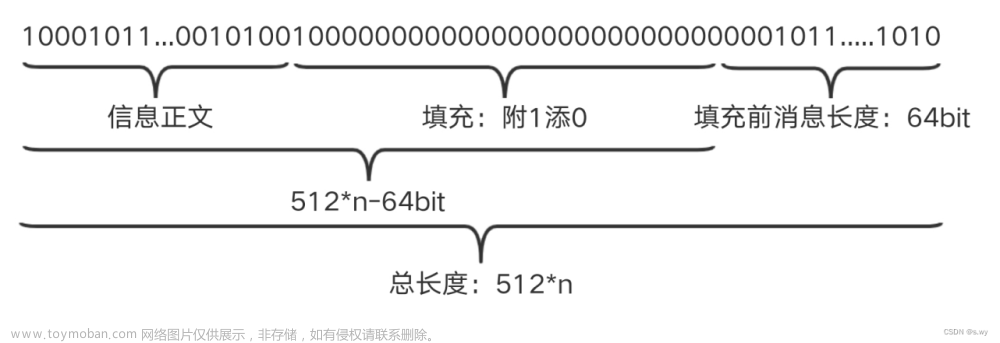普通子树哈希
树上的很多东西都是转化成链上问题的,比如树上哈希
树上哈希,主要是用于树的同构这个东西上的
什么是树的同构?
如图,不考虑节点编号,三棵树是同构的
将树转化成链,一般有两种方式:环游欧拉序与欧拉序
为了尽可能减少哈希冲突,进制位越小越好
又因为不考虑节点编号,很明显,若是采用欧拉序的话,得要记录该节点孩子数
环游欧拉序只用进入打上1,出来打上2即可搞定
小tips:欧拉序相较于环游欧拉序可能更快,请量力而行
于是,就可以采用普通的哈希方式啦!
指定范围子树哈希
如果说是将子树横着割一刀呢?
如图,是一棵树
放心,就60个节点
我们考虑D节点的子树中,距离D不超过3的所有点
如图
接着是环游欧拉序(考虑在某些原因的份上,我只保留D的子树)
为什么我只写到10?因为作者实在太懒因为到10就够了
对于范围树上哈希,我们有两种方式——拼接与删除
因为哈希一般在取模的意义下,所以,删除是非常难以做到的 (作者亲测过)
那只剩下拼接了,这个就和链上拼接一模一样了(也很像是前缀和)
模板题

题目主要考的是范围树上哈希
如果说看懂了前面的,这题就不难了。首先可以二分。因为若是
k
k
k是答案,那么一定存在两个节点的
k
k
k层子树是同构的。在其中任选两个对应的点,所组成的子树的子树一定是同构的
这么说显得很烦,翻译成人化就是:对于每个符合题目要求的
k
k
k层的两个子树(就是这两个字叔同构),他们的所有子树中一定有同构的,并且层数有
0
0
0、有
1
1
1、有
⋯
\cdots
⋯、有
k
−
1
k-1
k−1文章来源:https://www.toymoban.com/news/detail-704038.html
于是,题目就这样转化成了求是否存在同构的
k
k
k层子树
我们可以对于每个节点,求出它的
k
k
k层祖先,代表这个节点绝对存在
k
k
k层子树;
再找出
k
+
1
k+1
k+1曾祖先,代表这个节点的子树将要在他的祖先的子树中被删去(不被添加)
最后用一个map(建议使用gp_hash_table)统计答案
题目就这么结束了文章来源地址https://www.toymoban.com/news/detail-704038.html
代码
#pragma GCC optimize(1, "inline", "Ofast")
#pragma GCC optimize(2, "inline", "Ofast")
#pragma GCC optimize(3, "inline", "Ofast")
#include <bits/stdc++.h>
#include <bits/extc++.h>
using namespace std;
namespace IO {
class input {
private:
bool isdigit(char c) { return ('0' <= c && c <= '9'); }
public:
input operator>>(int &x) {
x = 0;
bool y = 1;
char c = getchar();
while (!isdigit(c)) y &= (c != '-'), c = getchar();
while (isdigit(c)) x = (x << 1) + (x << 3) + (c ^ 48), c = getchar();
if (!y)
x = -x;
return *this;
}
input operator>>(short &x) {
x = 0;
bool y = 1;
char c = getchar();
while (!isdigit(c)) y &= (c != '-'), c = getchar();
while (isdigit(c)) x = (x << 1) + (x << 3) + (c ^ 48), c = getchar();
if (!y)
x = -x;
return *this;
}
input operator>>(bool &x) {
x = 0;
bool y = 1;
char c = getchar();
while (!isdigit(c)) y &= (c != '-'), c = getchar();
while (isdigit(c)) x = (x << 1) + (x << 3) + (c ^ 48), c = getchar();
if (!y)
x = -x;
return *this;
}
input operator>>(long &x) {
x = 0;
bool y = 1;
char c = getchar();
while (!isdigit(c)) y &= (c != '-'), c = getchar();
while (isdigit(c)) x = (x << 1) + (x << 3) + (c ^ 48), c = getchar();
if (!y)
x = -x;
return *this;
}
input operator>>(long long &x) {
x = 0;
bool y = 1;
char c = getchar();
while (!isdigit(c)) y &= (c != '-'), c = getchar();
while (isdigit(c)) x = (x << 1) + (x << 3) + (c ^ 48), c = getchar();
if (!y)
x = -x;
return *this;
}
input operator>>(__int128 &x) {
x = 0;
bool y = 1;
char c = getchar();
while (!isdigit(c)) y &= (c != '-'), c = getchar();
while (isdigit(c)) x = (x << 1) + (x << 3) + (c ^ 48), c = getchar();
if (!y)
x = -x;
return *this;
}
input operator>>(unsigned int &x) {
x = 0;
bool y = 1;
char c = getchar();
while (!isdigit(c)) y &= (c != '-'), c = getchar();
while (isdigit(c)) x = (x << 1) + (x << 3) + (c ^ 48), c = getchar();
if (!y)
x = -x;
return *this;
}
input operator>>(unsigned short &x) {
x = 0;
bool y = 1;
char c = getchar();
while (!isdigit(c)) y &= (c != '-'), c = getchar();
while (isdigit(c)) x = (x << 1) + (x << 3) + (c ^ 48), c = getchar();
if (!y)
x = -x;
return *this;
}
input operator>>(unsigned long &x) {
x = 0;
bool y = 1;
char c = getchar();
while (!isdigit(c)) y &= (c != '-'), c = getchar();
while (isdigit(c)) x = (x << 1) + (x << 3) + (c ^ 48), c = getchar();
if (!y)
x = -x;
return *this;
}
input operator>>(unsigned long long &x) {
x = 0;
bool y = 1;
char c = getchar();
while (!isdigit(c)) y &= (c != '-'), c = getchar();
while (isdigit(c)) x = (x << 1) + (x << 3) + (c ^ 48), c = getchar();
if (!y)
x = -x;
return *this;
}
input operator>>(unsigned __int128 &x) {
x = 0;
bool y = 1;
char c = getchar();
while (!isdigit(c)) y &= (c != '-'), c = getchar();
while (isdigit(c)) x = (x << 1) + (x << 3) + (c ^ 48), c = getchar();
if (!y)
x = -x;
return *this;
}
input operator>>(double &x) {
x = 0;
bool y = 1;
char c = getchar();
while (!isdigit(c)) y &= (c != '-'), c = getchar();
while (isdigit(c)) x = x * 10 + (c ^ 48), c = getchar();
if (!y)
x = -x;
if (!isdigit(c))
if (c != '.')
return *this;
double z = 1;
while (isdigit(c)) z /= 10., x = x + z * (c ^ 48), getchar();
return *this;
}
input operator>>(long double &x) {
x = 0;
bool y = 1;
char c = getchar();
while (!isdigit(c)) y &= (c != '-'), c = getchar();
while (isdigit(c)) x = x * 10 + (c ^ 48), c = getchar();
if (!y)
x = -x;
if (!isdigit(c))
if (c != '.')
return *this;
double z = 1;
while (isdigit(c)) z /= 10., x = x + z * (c ^ 48), c = getchar();
return *this;
}
input operator>>(float &x) {
x = 0;
bool y = 1;
char c = getchar();
while (!isdigit(c)) y &= (c != '-'), c = getchar();
while (isdigit(c)) x = x * 10 + (c ^ 48), c = getchar();
if (!y)
x = -x;
if (!isdigit(c))
if (c != '.')
return *this;
double z = 1;
while (isdigit(c)) z /= 10., x = x + z * (c ^ 48), c = getchar();
return *this;
}
input operator>>(std::string &x) {
char c = getchar();
x.clear();
while (!(c != ' ' && c != '\n' && c != ' ' && c != EOF && c)) c = getchar();
while (c != ' ' && c != '\n' && c != ' ' && c != EOF && c) {
x.push_back(c);
c = getchar();
}
return *this;
}
input operator>>(char *x) {
char c = getchar();
int cnt = 0;
while (!(c != ' ' && c != '\n' && c != ' ' && c != EOF && c)) c = getchar();
while (c != ' ' && c != '\n' && c != ' ' && c != EOF && c) {
x[cnt++] = c;
c = getchar();
}
return *this;
}
input operator>>(char x) {
x = getchar();
return *this;
}
} pin;
}; // namespace IO
inline void wt(char ch) { putchar(ch); }
template <class T>
inline void wt(T x) {
static char ch[40];
int p = 0;
if (x < 0)
putchar('-'), x = -x;
do
ch[++p] = (x % 10) ^ 48, x /= 10;
while (x);
while (p) putchar(ch[p--]);
}
template <class T, class... U>
inline void wt(T x, U... t) {
wt(x), wt(t...);
}
#define int unsigned long long
const int N = 1e5 + 7;
int n;
const int M = 2e5 + 7;
struct edge {
int v, w, nxt;
} e[M];
int head[N], ct;
const int T = 19, K = 3;
int ll[N], x[M], nx[N];//x一定要开两倍!!!
int l[N], r[N];
int tp;
int getpw(int d) { return ll[d]; }
void addE(int u, int v, int w = 0) {
e[++ct] = { v, w, head[u] };
head[u] = ct;
}
void saddE(int u, int v, int w = 0) { addE(u, v, w), addE(v, u, w); }
int fa[N][T + 1];
__gnu_pbds::gp_hash_table<int, bool> cun;
void getx(int u = 1, int faa = 0) {
l[u] = ++tp;
x[tp] = (x[tp - 1] * K + 1);
fa[u][0] = faa;
for (int i = head[u]; i; i = e[i].nxt) {
int v = e[i].v;
getx(v, u);
}
r[u] = ++tp;
x[tp] = (x[tp - 1] * K + 2);
}
int ytl[N];
typedef pair<int, int> pii;
vector<pii> vt[N];
bool chk(int mid) {
memset(nx, 0, sizeof nx);
cun.clear();
memset(ytl, 0, sizeof ytl);
for (int i = 1; i <= n; i++) vt[i].clear();
for (int i = 1; i <= n; i++) {
int tl = i;
for (int j = T, k = mid; ~j; j--)
if ((1ull << j) <= k)
k -= (1ull << j), tl = fa[tl][j];
if (tl == 0)
continue;
ytl[tl] = 1;
tl = fa[tl][0];
if (tl == 0)
continue;
// out<<i<<" "<<tl<<endl;
vt[tl].push_back(pii(l[i], i));
}
for (int i = 1; i <= n; i++) sort(vt[i].begin(), vt[i].end());
bool flg = 0;
for (int i = 1; i <= n; i++) {
if (!ytl[i])
continue;
int lr = l[i];
for (auto j : vt[i]) {
int k = j.second;
// cout<<k<<endl;
(nx[i] *= getpw(l[k] - lr));
(nx[i] += x[l[k] - 1] - (x[lr - 1] * getpw(l[k] - lr)));
// cout<<x[l[k]-1]<<" "<<x[lr-1]<<" "<<nx[i]<<endl;
lr = r[k] + 1;
}
(nx[i] *= getpw(r[i] - lr + 1));
(nx[i] += x[r[i]] - (x[lr - 1] * getpw(r[i] - lr + 1)));
if (cun[nx[i]])
return 1;
// cout<<nx[i]<<endl;
cun[nx[i]] = 1;
// cout<<nx[i]<<endl;
// puts("");
}
return flg;
}
main() {
freopen("tree.in", "r", stdin);
freopen("tree.out", "w", stdout);
ll[0] = 1;
for (int i = 1; i < N; i++) ll[i] = (ll[i - 1] * K);
IO::pin >> n;
for (int i = 1, x, y; i <= n; i++) {
IO::pin >> x;
while (x--) IO::pin >> y, addE(i, y);
}
getx();
for (int j = 1; j <= T; j++)
for (int i = 1; i <= n; i++) fa[i][j] = fa[fa[i][j - 1]][j - 1];
int l = 0, r = n - 1;
while (l < r) {
int mid = l + r + 1 >> 1;
// cout<<l<<" "<<r<<" "<<mid<<endl;
if (chk(mid))
l = mid;
else
r = mid - 1;
}
printf("%llu\n", l);
}
到了这里,关于学习笔记——树上哈希的文章就介绍完了。如果您还想了解更多内容,请在右上角搜索TOY模板网以前的文章或继续浏览下面的相关文章,希望大家以后多多支持TOY模板网!









